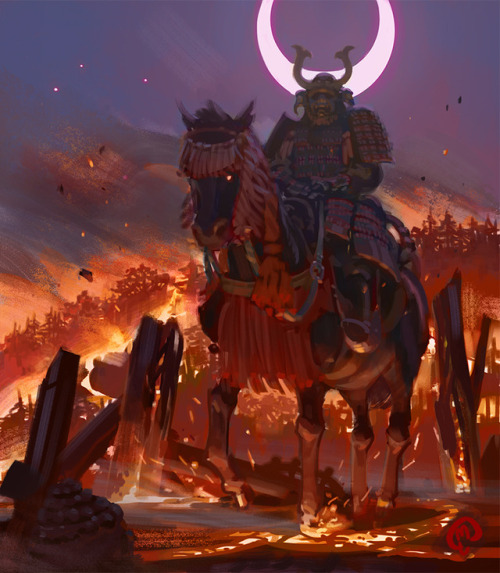#sengoku jidai
1582, The Death of Akechi Mitsuhide
After the successful Akechi lead coup against Nobunaga, Mitsuhide claimed himself the new Shogun of Japan. He quickly moved to secure this position by reaching out to allies and the Emperor. However, Mitsuhide’s allies had already begun to separate themselves from him. Outreach to the Emperor was also half-hearted and did not ease a nervous Imperial Court. Nobunaga’s generals who were off fighting during the assassination began their return to deal with the usurper and secure their positions for the oncoming power struggle. As Nobunaga’s retainers closed in, Mitsuhide’s campaign for support quickly deteriorated causing his soldiers to leave by the thousands. He gravely miscalculated Nobunaga’s popularity as the entire country was turning against him.
After four days, Hashiba Hideyoshi, a devout Oda-retainer, caught up to the Akechi army. He managed to sway two other Oda retainers to his side, swelling his forces to 20,000 - twice that of the Akechi army. The two forces met at the Battle of Yamazaki. After just two hours of fighting, the Akechi army was completely routed. Mitsuhide fled the battle and retreated to the nearby village of Ogurusu. As he was fleeing, a bandit lept out from hiding and thrust his spear into him. Mitsuhide had been killed, his reign as Shogun lasting a paltry 13 days.
Though Hideyoshi had avenged Nobunaga’s death, the victory was short lived. All out war was apparent as this sudden power shift completely fractured any sense of stability in Japan. Leaders retreated to their strongholds to plan how best to secure power over the arising conflict.
Post link
1582, Honno-Ji Burns
Nobunaga had consolidated his power over most of Japan and had begun his final push to eliminate what few clans remained. Hashiba Hideyoshi was leading a western assault against the powerful Mori clan. Nobunaga had left to join the campaign, but had stopped at Honno Temple, his usual resting place in the capital of Kyoto. Mitsuhide had been ordered to rendezvous with Hideyoshi to support his efforts. Instead, he was marching towards Honno-Ji with a force of 13,000 men ready to overthrow Nobunaga. As Nobunaga’s generals and armies were all off fighting on different fronts, his only company were servants, bodyguards, court officials, and merchants.
Mitsuhide’s march towards Kyoto went unchecked as he used previous demonstrations in the city as a pretext to belay suspicion. As they crossed the Katsura River, Mitsuhide exclaimed “the enemy awaits at Honno-Ji!” Before sunrise, the temple was surrounded and Mitsuhide had begun his attack. Nobunaga and his company were taken by surprise and could not defend against the sheer number of troops. Rather than give the traitors the satisfaction of his head as a prize, Nobunaga ordered the temple to be burned down. He then committed ritual suicide, his body soon claimed by the flames. So ended the rule of the Demon King, Nobunaga.
Mitsuhide then began his own consolidation of power by claiming himself the new Shogun. However, besides the few holdouts, Japan had been ready to accept an Oda-Shogunate. Peace had begun setting in as quarrelsome provinces and rivals had been pacified. Without Nobunaga, ambition and the desire for power crept back into the land. Mitsuhide’s treacherous act would fracture the entire country, leading to all out war for the next two decades…
Post link
1579, Mitsuhide’s Betrayal
After crushing the Takeda at Nagashino and further successful campaigns, Nobunaga’s path to become the next Shogun was on the horizon. Nobunaga’s rivals had either been dealt with or chose to become vassals to spare themselves from his wrath. Peace and a sense of normalcy was returning to the countryside as the war finally drew to a close.
However, one Oda retainer did not share the dream of a Shogunate run by the Demon King. Akechi Mitsuhide, a loyal, intelligent, and well-trusted retainer had been by Nobunaga’s side for years. These qualities made Mitsuhide’s decision all the more shocking. Reasons for Mitsuhide’s next actions varies by historical documents. Some say Nobunaga betrayed Mitsuhide’s trust and executed a general to whom he promised safety. This ultimately lead to a revenge killing of Mitsuhide’s mother. Others say Nobunaga constantly downplayed Mitsuhide’s achievements and contributions, and would openly insult him in public. Perhaps Mitsuhide simply feared Nobunaga’s temperamental mood (possibly bipolar) would unleash brutalities on the public. Whatever the case may be, Mitsuhide’s support for Nobunaga had vanished.
As Hashiba Hideyoshi was off fighting the Mori Clan, Mitsuhide was ordered to march west and support his efforts. Instead, Mitsuhide gathered his most trusted senior retainers and spoke in secrecy. An army of 13,000 men was amassed. Mitsuhide’s sites had been set on Honno-Ji Temple to save Japan from the Demon King.
Post link
1571, Siege of Mt. Hiei.
During the Sengoku Jidai, the “Warring States Era” of Japan, many of the warlords faced resistance from the Ikko-Ikki, a rebellious sect of Buddhist monks opposed to the Shogunate and local Daimyos. As provinces were pacified, the monks would sow discord, throwing peaceful areas back into chaos. They were a constant source of unrest, especially for the warlord Oda Nobunaga. As Nobunaga’s sudden and surprising rise to power increased, so did Ikko-Ikki lead rebellions.
Tired of being undermined, Nobunaga launched a fierce campaign directly targeting the monks. The Ikko-Ikki were pushed back to the temple stronghold on Mt. Hiei, one of two historic founding schools of Buddhism in Japan. Nobunaga surrounded the mountain and sieged the temple for months, only to prolong the suffering of those inside. Any who surrendered to the Oda army were summarily executed.
To end the siege, Nobunaga set the mountain on fire and burned the temple to the ground. All those inside perished in the fire, effectively ending the Ikko-Ikki rebellion.
After this and other instances of brutal punishment, Nobunaga became widely known as “Demon Nobunaga”.
Post link




